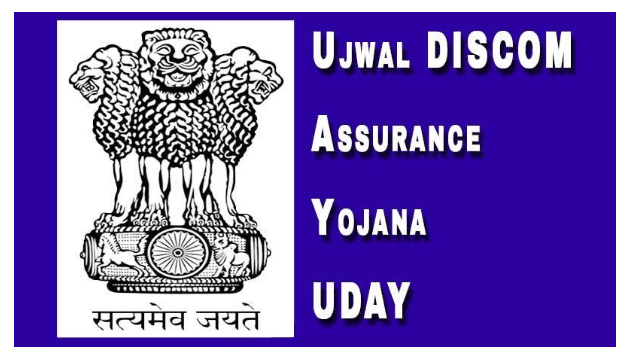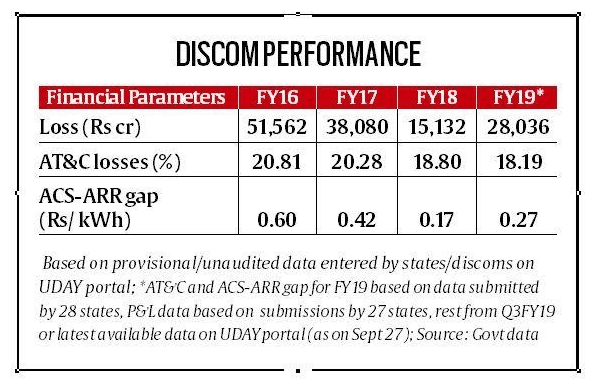UPSC Articles
POLITY
TOPIC:General Studies 2:
- Government policies and interventions for development in various sectors and issues arising out of their design and implementation.
Ujwal DISCOM Assurance Yojana (UDAY): sharp spike in discom losses

Daily Current Affairs IAS | UPSC Prelims and Mains Exam – 23rd December 2019
Context:
- Discom losses, which had progressively reduced in the first couple of years since the scheme’s rollout in November 2015, have rebounded in FY ’19 to nearly double the losses recorded the previous year.
- Book losses of discoms, which had reduced from Rs 51,562 crore in FY ’16 to Rs 15,132 crore in FY ’18, have nearly doubled this financial year to Rs 28,036 crore,
- Discoms have also missed the FY ’19 UDAY target to bring down their aggregate technical and commercial (AT&C) losses to 15 per cent.

Daily Current Affairs IAS | UPSC Prelims and Mains Exam – 23rd December 2019
Reason for failure:
- The primary reason for failure, as is being recognised in policy circles, is the failure of discoms to collect the full cost that they pay for power — the same issue that had led to the floundering of the previous two schemes.
Solutions:
- Franchise or PPP models.
- The Centre is also likely to back up the new scheme by providing some grant support, which it did not do in UDAY.
Problems with the Sector:
The massive transmission and distribution losses can be attributed to the following reasons:
- Inadequate Tariff increases
- Poor Power purchase planning
- Sale of power at prices lower than the discom’s procurement costs
- Political Willingness
- Lack of timely Subsidy Payments
- Inefficiencies in metering and billing
- Illegal Connections
- Reckless funding by banks to loss-making Discoms
Why UDAY?
- The UDAY Scheme (not compulsory) will pave way for the takeover of the 75 per cent of Discom liabilities by state governments over a two-to-five year period
- Financing of the Debt: Via bonds with a maturity period of 10-15 years
- Effects:
- It will help relieve debt-ridden discoms
- It will lead to the acceptance of debts in the balance sheet of the discom while encouraging them to align tariffs to costs and ensuring the sustainable working of the same
The utility of UDAY:
- Unsustainable borrowings should be curbed to put a stop on ever-increasing loss. Under Uday, the future losses can be permitted to finance only when a discom bond is guaranteed by the State Government, thus ensuring that the discom applies a profitable discretion
- With elements like the guided intervention of the State governments and the graded manner in which it needs to be taken up, the scheme assumes an all-season ongoing approach and not a one-time settlement effort.
- Certain conditions put across by Uday involves:
- Loss reduction needs to be aided by circle-wise targets, feeder and DT Metering as well as upgrading and replacement of transformers
- Regions with sustained loss reduction should be incentivised (rewarded) by increased hours of supply
- Other initiatives that can be taken to reduce discom inefficiencies:
- Laying down a specific performance-monitoring & compliance mechanism (can be incentivised by additional funding and other inputs)
- Monitoring of lending by banks to ensure reliable supply of investment
- Ensure regular tariff setting
- Energy auditing of feeders
- Metering of distribution transformers (DT)
- Elimination of revenue gaps
- Allow fuel-cost adjustments in final tariffs
- Reduction in short-term power purchase
- Liquidation of Regulatory Assets
- Ensuring advance payments of subsidies
Attractive to States:
- The additional liability will not be considered for assessing fiscal responsibility limits of States
- The 3 to 4 percentage point reduction in interest rates will serve as a relief
Issues with Uday
- State Subject: Electricity is not a Central subject and thus, the scheme cannot be made a compulsory one- which leaves the door open for unequal working of the Discom per State.
- No monetary assistance is being provided by the State though states willing to become a part of the scheme will be granted with subsidised funding in the government’s schemes and priority in the supply of coal
- The conversion of discom debt into bonds is not as difficult as is finding a suitable buyer for those bonds, not enjoying SLR Status additionally
IASbaba’s Views:
- Political unwillingness needs to be fixed and mechanisms need to be strictly followed to plug the loopholes to address the debt-ridden discoms and fix the losses.
- This restructuring package needs to be designed in a way that it can deal with both; an unexpected tariff shock or an increased burden on the State Government, taking into due consideration the certain measures that needs to be effectively worked out (enumerated above)
Connecting the Dots:
- Do surplus and shortages go together? Analyse
- In the light of the grave situation of power loss, can State prove to be a beacon of light, leading the path away from the crisis? Discuss














